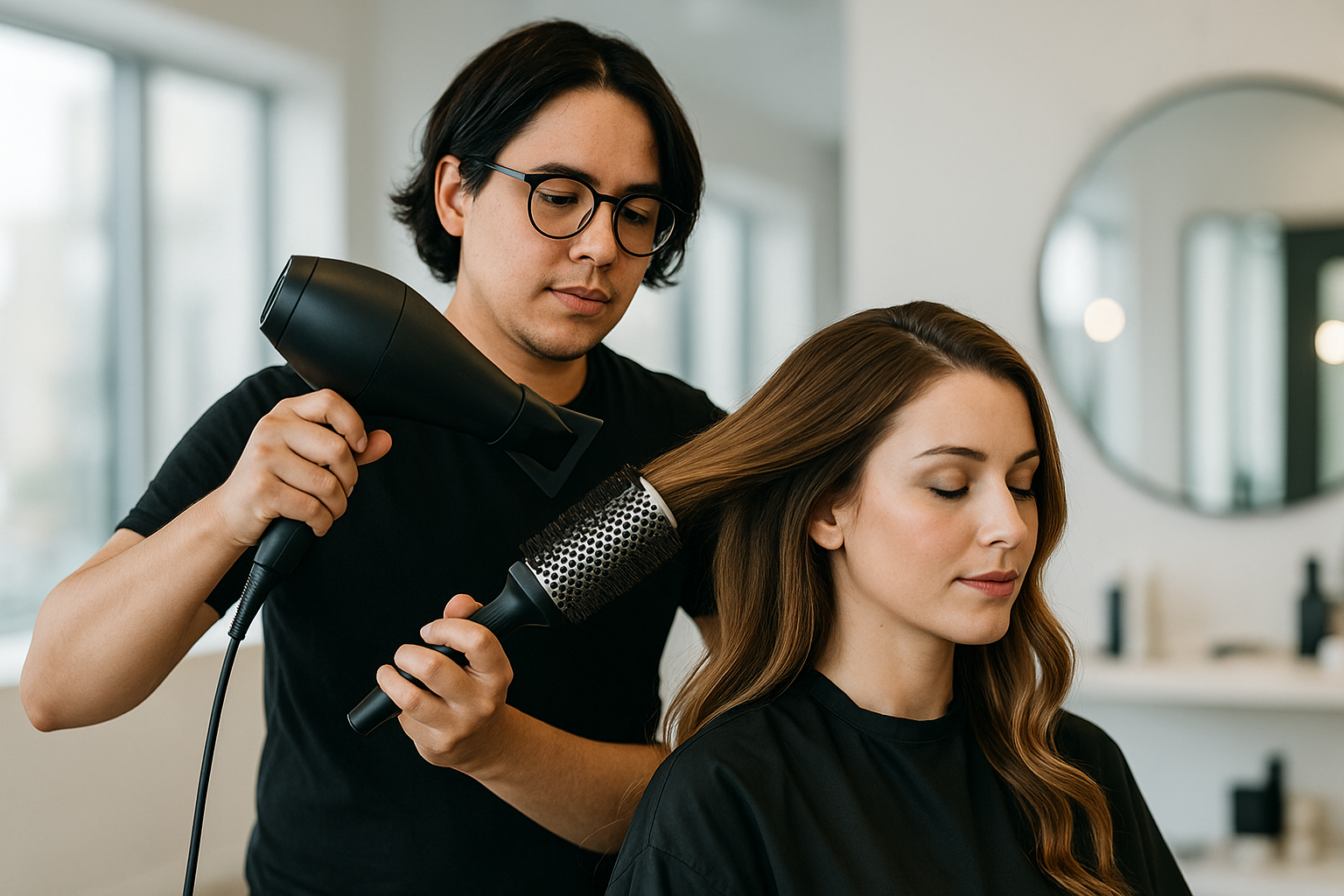Cosmetology Career Opportunities: What to Expect in 2025 and Beyond
Cosmetology offers a unique blend of artistic expression, technical skill, and personal interaction that few other careers can match. From transforming someone’s appearance with the perfect haircut to helping clients feel confident in their skin, cosmetology professionals make a tangible difference in people’s lives every day. With the beauty industry continuing to grow, diverse career paths available, and opportunities for self-employment, cosmetology provides rewarding options for creative, people-oriented individuals.
Why Cosmetology is a Thriving Career Choice
Market Drivers
Multiple factors support continued growth in the beauty industry:
- Self-care emphasis increasing beauty service demand
- Social media influence driving beauty trends and services
- Male grooming market expanding service opportunities
- Anti-aging treatments creating new specialty areas
- Wellness integration combining beauty and health services
Career Advantages
Cosmetology offers unique benefits:
- Creative expression in daily work
- Flexible scheduling options
- Strong client relationships
- Low barrier to business ownership
- Recession-resistant services (personal care continues)
- Variety of specialization options
Cosmetology Career Paths
Entry-Level Positions
- Assistant Stylist/Apprentice: $22,000-$32,000 annually
- Junior Stylist: $25,000-$38,000 annually (plus tips)
- Salon Receptionist/Manager Track: $24,000-$35,000 annually
Experienced Professional Roles
- Hair Stylist: $30,000-$55,000 annually (plus tips)
- Esthetician: $28,000-$50,000 annually (plus tips)
- Nail Technician: $25,000-$45,000 annually (plus tips)
- Makeup Artist: $30,000-$70,000 annually (highly variable)
Advanced and Specialized Positions
- Master Stylist/Colorist: $45,000-$75,000+ annually
- Medical Esthetician: $35,000-$60,000 annually
- Platform Artist/Educator: $50,000-$80,000+ annually
- Salon Manager: $35,000-$60,000 annually
- Salon Owner: $40,000-$150,000+ annually (highly variable)
Note: Income in cosmetology often includes significant tip income not reflected in base salary figures. Total compensation can be 30-50% higher when including gratuities.
Specialization Opportunities
Hair Services
Hair Styling and Cutting
- Women’s haircuts and styling
- Men’s grooming and barbering
- Precision cutting techniques
- Formal styling (weddings, events)
- Extensions and hair additions
- Keratin treatments and smoothing
Hair Color Specialist
- Color correction
- Balayage and ombre techniques
- Fashion and vivid colors
- Gray coverage and blending
- Highlights and lowlights
- Color formulation expertise
- Often highest-earning specialty
Texture Services
- Perming and permanent waves
- Keratin smoothing treatments
- Japanese straightening
- Brazilian blowouts
- Curl reformation
Skincare and Esthetics
Clinical Esthetician
- Facials and skin treatments
- Chemical peels
- Microdermabrasion
- LED light therapy
- Extractions and deep cleaning
- Product recommendations
Medical Esthetician
- Pre and post-surgical care
- Laser treatment assistance
- Cosmetic injectables support (in some states)
- Scar treatment
- Medical-grade skincare
- Dermatology office setting
- Higher compensation
Spa Services
- Body treatments and wraps
- Waxing and hair removal
- Relaxation treatments
- Aromatherapy
- Hot stone massage (with additional license)
- Luxury spa environment
Nail Technology
Manicure and Pedicure Specialist
- Natural nail care
- Gel and shellac applications
- Acrylic nail extensions
- Nail art and design
- Paraffin treatments
- Foot care and pampering
Nail Art Specialist
- Complex nail designs
- 3D nail art
- Airbrush techniques
- Competition work
- Social media presence
- Premium pricing for specialty work
Makeup Artistry
Bridal Makeup
- Wedding makeup services
- Bridal party applications
- Trial sessions
- On-location services
- High-stress, high-reward specialty
- Premium event pricing
Special Effects and Editorial
- Film and television makeup
- Theater and stage makeup
- Fashion photography
- Editorial shoots
- Special effects (with additional training)
- Portfolio-driven work
Retail and Counter Makeup
- Department store beauty counters
- Cosmetics brand representation
- Product sales and commission
- Steady income with benefits
- Customer education
Education and Training Requirements
Training Pathways
- Cosmetology school: 1,000-2,100 hours (varies by state)
- Esthetics programs: 300-750 hours (varies by state)
- Nail technology programs: 200-600 hours (varies by state)
- Barbering programs: 1,000-1,500 hours (varies by state)
- Makeup artistry: No license required in most states, but training beneficial
State Licensing Requirements
All states require licenses for:
- Cosmetology: State board written and practical exam
- Esthetics: Separate license, less training than full cosmetology
- Nail Technology: Separate license available in most states
- Barbering: Separate license with different curriculum focus
- Instructor License: Additional requirements for teaching
Important Certifications
Beyond basic licensing:
- Advanced education certifications (specific brands/techniques)
- Redken, Paul Mitchell, Aveda brand certifications
- Eyelash extension certification
- Microblading certification (esthetics plus specialty training)
- Spray tan certification
- Permanent makeup (extensive additional training)
Continuing Education
Most states require ongoing education:
- Sanitation and safety updates
- New technique training
- Product knowledge courses
- Business management training
- Typically 8-16 hours per renewal period
What Makes a Successful Cosmetology Professional
Technical Skills
- Precise cutting and styling techniques
- Color theory and application
- Chemical service knowledge
- Skin analysis and treatment
- Sanitation and safety protocols
- Product chemistry understanding
- Manual dexterity and coordination
Artistic Abilities
- Understanding of facial proportions and features
- Color sense and aesthetic judgment
- Ability to visualize end results
- Trend awareness and adaptation
- Creative problem-solving
- Personal style development
Interpersonal Skills
- Active listening and consultation
- Customer service excellence
- Managing expectations
- Handling difficult situations
- Building client relationships
- Professional communication
Business Acumen
- Time management and scheduling
- Pricing and profitability
- Retail sales abilities
- Self-marketing and promotion
- Social media presence
- Financial management
Physical and Mental Requirements
- Physical stamina (standing all day)
- Hand and wrist strength
- Tolerance for repetitive motions
- Chemical sensitivity awareness
- Emotional resilience
- Patience and focus
Industry Outlook
Job Growth Projections
According to the Bureau of Labor Statistics:
- Hairdressers and cosmetologists: Growing steadily
- Skincare specialists: Expected to grow 13% through 2032
- Barbers: Expected to grow 7% through 2032
- Nail technicians: Expected to grow 7% through 2032
- Strong demand for skilled professionals
Market Trends
Growing areas in the beauty industry:
- Men’s grooming services expanding rapidly
- Medical esthetics (medspa services)
- Natural and organic products
- Sustainable beauty practices
- Customized treatments using technology
- Wellness integration (beauty and health)
High-Demand Employment Settings
- Full-service salons: One-stop beauty services
- High-end specialty salons: Luxury clientele
- Barbershops: Traditional and modern men’s grooming
- Medical spas: Clinical treatments
- Destination spas: Resort and wellness centers
- Cruise ships: Travel opportunities
- Retirement communities: Underserved growing market
- Mobile services: On-location convenience
Tools and Equipment Investment
Hair Styling Essentials
Beginning stylists typically invest in:
- Professional shears (multiple pairs)
- Clippers and trimmers
- Blow dryers and diffusers
- Flat irons and curling tools
- Brushes and combs (variety)
- Capes, clips, and accessories
- Initial investment: $500-$1,500
Esthetics Equipment
Estheticians often purchase:
- Facial tools and implements
- Extraction tools
- Steamer (sometimes provided)
- Product inventory
- Towels and linens
- Investment: $300-$1,000
Nail Technology Kit
Nail technicians need:
- Nail files and buffers
- Cuticle tools
- Gel lamp and supplies
- Acrylic system
- Polish collection
- Sanitation equipment
- Investment: $400-$1,200
Employer-Provided Equipment
Most salons provide:
- Styling chairs and stations
- Shampoo bowls
- Facial beds (for estheticians)
- Major equipment (steamers, processors)
- Retail product inventory
- Laundry facilities
Business Models and Compensation Structures
Employment Arrangements
Commission-Based
- Earn percentage of service sales (typically 40-60%)
- Higher earning potential
- Income fluctuates with clientele
- Must build and maintain client base
- Most common for experienced professionals
Hourly/Salary
- Predictable income
- Lower risk for new professionals
- May include benefits
- Less direct incentive for performance
- Often for entry-level or management
Booth/Suite Rental
- Rent space in salon ($100-$400+ weekly)
- Keep 100% of service income
- Pay own taxes and insurance
- Control own schedule and pricing
- Need established clientele
- Entrepreneurial option
Service + Commission
- Base hourly pay plus commission
- Balances security and performance incentive
- Common for mid-level professionals
- Provides stability while building clientele
Tip Income
Gratuities significantly impact total compensation:
- Typically 15-20% of service price
- Can add $10,000-$30,000+ annually
- Quality service directly rewarded
- Client relationship dependent
- Cash tips vs. credit card (reporting differences)
Self-Employment and Business Ownership
Salon Ownership
Starting a salon requires:
- Business license and permits
- Commercial space lease
- Equipment and product inventory
- Insurance (liability, property)
- Hiring and managing staff
- Marketing and client acquisition
- Initial investment: $50,000-$250,000+
Alternative Business Models
- Suite rental facilities: Lower overhead than traditional salon
- Mobile/home-based services: Lowest startup cost
- Specialized niche salons: Focus on specific service
- Education and training: Teaching other professionals
- Product line development: Leverage expertise
Success Factors for Business Owners
- Strong technical skills and reputation
- Business management abilities
- Marketing and social media savvy
- Financial management
- Staff recruitment and retention
- Customer service excellence
- Location selection
Marketing and Building Clientele
Essential Marketing Strategies
- Social media presence: Instagram, Facebook, TikTok
- Before-and-after photos: Visual proof of skills
- Client testimonials and reviews: Social proof
- Referral programs: Incentivize word-of-mouth
- Professional website: Online booking and information
- Networking: Community involvement and connections
Client Retention
Successful professionals focus on:
- Consistent quality service
- Reliable scheduling and punctuality
- Personalized consultations
- Retail product recommendations
- Follow-up communication
- Loyalty programs and incentives
- Building genuine relationships
Safety and Health Considerations
Occupational Hazards
Cosmetology professionals may face:
- Chemical exposure (hair color, nail products)
- Repetitive motion injuries (carpal tunnel)
- Standing-related issues (varicose veins, back pain)
- Skin conditions from water/chemical exposure
- Inhalation of fumes and dust
- Allergic reactions to products
Safety Protocols
Professional practices include:
- Proper ventilation in work areas
- Personal protective equipment (gloves, masks)
- Sanitation and disinfection procedures
- Ergonomic work habits
- Regular breaks and stretching
- Product ingredient awareness
Regulatory Compliance
Cosmetology businesses must follow:
- State board sanitation requirements
- OSHA regulations for chemicals
- Blood-borne pathogen standards
- EPA regulations for waste
- ADA accessibility requirements
- Regular inspections and licensure
Getting Started in Cosmetology
First Steps
- Research state requirements for licensing
- Visit beauty schools to compare programs
- Shadow professionals to observe daily work
- Assess your interests (hair vs. skin vs. nails)
- Consider financial investment (tuition, tools, time)
Choosing the Right School
Look for programs offering:
- State board accredited curriculum
- Experienced instructor staff
- Modern facilities and equipment
- Small class sizes for individual attention
- Business and marketing education
- Job placement assistance
- Flexible scheduling options
- Financial aid availability
Building Your Career
After graduation:
- Pass state board exams on first attempt (prepare thoroughly)
- Start at reputable salon (learn from experienced stylists)
- Continue education (advanced techniques and trends)
- Build clientele consistently
- Develop social media presence
- Network within the industry
- Consider specialization after foundational experience
Career Advancement and Growth
Progression Paths
Cosmetology professionals advance by:
- Building large, loyal client base
- Specializing in high-demand services
- Becoming master colorist or stylist
- Managing salon operations
- Opening their own businesses
- Becoming platform artists or educators
- Working with celebrities or in media
- Developing product lines
Platform Artist/Educator
Teaching opportunities include:
- Beauty school instruction
- Brand education representative
- Platform artist for trade shows
- Workshop and seminar presenter
- Online education content creation
- Higher income and travel opportunities
Work-Life Considerations
Positive Aspects
- Creative and artistic work
- Meaningful client relationships
- Flexible scheduling potential
- Varied day-to-day experiences
- Immediate visual results
- Gratitude and appreciation from clients
- Options for self-employment
- Never boring or monotonous
Challenging Aspects
Be prepared for:
- Weekend and evening work (when clients are free)
- Physical demands of standing all day
- Variable income (especially when building clientele)
- Dealing with difficult clients occasionally
- Keeping up with constant industry changes
- Initial lower earnings while establishing yourself
- Chemical exposure and potential sensitivities
- High-stress during busy times
Conclusion
Cosmetology offers a rewarding career path for creative, people-oriented individuals who want to make a tangible difference in how people look and feel. The combination of artistic expression, technical skill, interpersonal connection, and entrepreneurial opportunity makes it a unique profession unlike traditional trades or office careers.
While the beauty industry is competitive, skilled professionals who provide excellent service, build strong client relationships, and continue their education can build thriving careers with good income potential. The relatively low barrier to entry, combined with diverse career paths and flexibility, makes cosmetology accessible to those willing to invest in proper training and dedicate themselves to their craft.
Whether you envision yourself as a sought-after hair colorist, a medical esthetician in a dermatology practice, a nail artist with a social media following, or a successful salon owner, cosmetology provides the foundation to build a career aligned with your interests and goals. The work is personal, creative, and relationship-driven—if that appeals to you, cosmetology deserves serious consideration.
Ready to transform your future? Research accredited cosmetology programs in your area, visit local salons to understand the culture and expectations, and take the first step toward joining this creative and rewarding profession.



